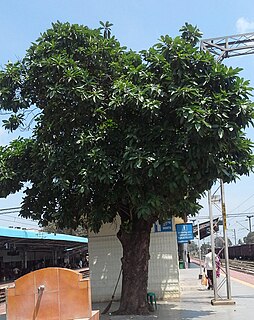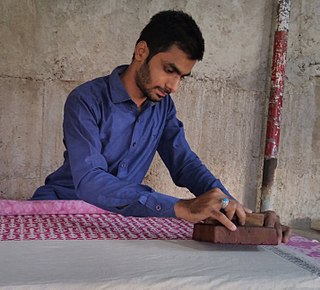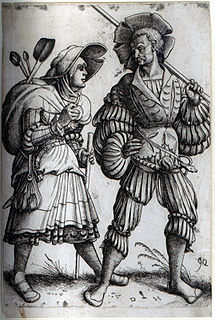
A dye is a colored substance that chemically bond to the substrate to which it is being applied, this distinguishes dyes from pigments which do not chemically bind to the material they colour. The dye is generally applied in an aqueous solution, and may require a mordant to improve the fastness of the dye on the fiber.

Otto Mann is a fictional character on the animated TV series The Simpsons, voiced by Harry Shearer. He is the school bus driver for Springfield Elementary School.

Haematoxylin or hematoxylin, also called natural black 1 or C.I. 75290, is a compound extracted from heartwood of the logwood tree with a chemical formula of C
16H
14O
6. This naturally derived dye has been used as a histologic stain, ink and as a dye in the textile and leather industry. In histology, haematoxylin staining is commonly followed (counterstained), with eosin, another stain. When paired, this staining procedure is known as H&E staining, and is one of the most commonly used combinations in histology. Although the stain is commonly called haematoxylin, an oxidized form, haematein, which forms strongly coloured complexes with certain metal ions, is the active colourant. In its pure form, haematoxylin is a colorless and crystalline solid, although commercial samples are typically light to dark-brown based on the level of impurities present
A fixative is a stabilizing or preservative agent:

Staining is an auxiliary technique used in microscopy to enhance contrast in the microscopic image. Stains and dyes are frequently used in biology and medicine to highlight structures in biological tissues for viewing, often with the aid of different microscopes. Stains may be used to define and examine bulk tissues, cell populations, or organelles within individual cells.

Maclura tinctoria, commonly known as old fustic or dyer's mulberry is a medium to large tree of the Neotropics, from Mexico to Argentina. It produces a yellow dye called fustic primarily known for coloring khaki fabric for U.S. military apparel during World War I. This dye contains the flavonoid morin.

Morinda tinctoria, commonly known as aal or Indian mulberry, is a species of flowering plant in the family Rubiaceae, native to southern Asia.

Mordant red 19 is an organic compound with the chemical formula C16H13ClN4O5S. It is classified as an azo dye.

Textile printing is the process of applying colour to fabric in definite patterns or designs. In properly printed fabrics the colour is bonded with the fibre, so as to resist washing and friction. Textile printing is related to dyeing but in dyeing properly the whole fabric is uniformly covered with one colour, whereas in printing one or more colours are applied to it in certain parts only, and in sharply defined patterns.

A candle wick is usually a braided cotton that holds the flame of an oil lamp or candle. A candle wick works by capillary action, conveying ("wicking") the fuel to the flame. When the liquid fuel, typically melted candle wax, reaches the flame it then vaporizes and combusts. The candle wick influences how the candle burns. Important characteristics of the wick include diameter, stiffness, fire-resistance, and tethering.

Hematoxylin and eosin stain or haematoxylin and eosin stain is one of the principal stains in histology. It is the most widely used stain in medical diagnosis and is often the gold standard; for example, when a pathologist looks at a biopsy of a suspected cancer, the histological section is likely to be stained with H&E. A combination of hematoxylin and eosin, it produces blues, violets, and reds.
Pittacal was the first synthetic dyestuff to be produced commercially. It was accidentally discovered in 1832 by German chemist Carl Ludwig Reichenbach, who is also recognized as being the discoverer of kerosene, phenol, eupion, paraffin wax and creosote.

Morindone is an anthraquinone compound obtained from various Morinda species, especially M. tinctoria, but also M. citrifolia. Its principal use is as a dye, but it has also been investigated for anticancer and microbial uses.
Mushrooms can be used to create color dyes via color-extraction with a solvent as well as particulation of raw material. The shingled hedgehog mushroom and related species contain blue-green pigments, which are used for dyeing wool in Norway. The fruiting body of Hydnellum peckii can be used to produce a beige color when no mordant is used, and shades of blue or green depending on the mordant added. Phaeolus schweinitzii produces green, yellow, gold, or brown colors, depending on the material dyed and the mordant used.

Natural dyes are dyes or colorants derived from plants, invertebrates, or minerals. The majority of natural dyes are vegetable dyes from plant sources—roots, berries, bark, leaves, and wood—and other biological sources such as fungi and lichens.

Dyeing is the craft of imparting colors to textiles in loose fiber, yarn, cloth or garment form by treatment with a dye. Archaeologists have found evidence of textile dyeing with natural dyes dating back to the Neolithic period. In China, dyeing with plants, barks and insects has been traced back more than 5,000 years. Natural insect dyes such as Tyrian purple and kermes and plant-based dyes such as woad, indigo and madder were important elements of the economies of Asia and Europe until the discovery of man-made synthetic dyes in the mid-19th century. Synthetic dyes quickly superseded natural dyes for the large-scale commercial textile production enabled by the industrial revolution, but natural dyes remained in use by traditional cultures around the world.
Aluminium triacetate, formally named aluminium acetate, is a chemical compound with composition Al(CH
3CO
2)
3. Under standard conditions it appears as a white, water-soluble solid that decomposes on heating at around 200 °C. The triacetate hydrolyses to a mixture of basic hydroxide / acetate salts, and multiple species co-exist in chemical equilibrium, particularly in aqueous solutions of the acetate ion; the name aluminium acetate is commonly used for this mixed system.
Aluminium sulfacetate is a chemical compound of aluminium with formula Al
2SO
4(CH
3CO
2)
4.
















